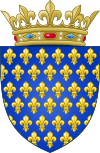Hugh, Count of Vermandois
| French Monarchy |
| Direct Capetians |
|---|
 |
| Hugh Capet |
| Robert II |
| Henry I |
| Philip I |
| Louis VI |
| Louis VII |
| Philip II |
| Louis VIII |
| Louis IX |
| Philip III |
| Philip IV |
| Louis X |
| John I |
| Philip V |
| Charles IV |
Hugh of Vermandois (1053 – October 18, 1101), was son to King Henry I of France and Anne of Kiev, and the younger brother of King Philip I of France. He was in his own right Count of Vermandois. William of Tyre called him "Hugh Magnus", Hugh the Great, but he was an ineffectual leader and soldier, great only in his boasting. Indeed, Sir Steven Runciman is certain that "Magnus" is a copyist's error, and should be "minus", "the younger" (referring to Hugh as younger brother of the King of France).
In early 1096 Hugh and Philip began discussing the First Crusade after news of the Council of Clermont reached them in Paris. Although Philip could not participate, as he had been excommunicated, Hugh was said to have been influenced to join the Crusade after an eclipse of the moon on February 11, 1096.
That summer Hugh's army left France for Italy, where they would cross the Adriatic Sea into territory of the Byzantine Empire, unlike the other Crusader armies who were travelling by land. On the way, many of the soldiers led by fellow Crusader Emicho joined Hugh's army after Emicho was defeated by the Hungarians, whose land he had been pillaging. Hugh crossed the Adriatic from Bari in Southern Italy, but many of his ships were destroyed in a storm off the Byzantine port of Dyrrhachium.
Hugh and most of his army was rescued and escorted to Constantinople, where they arrived in November of 1096. Prior to his arrival, Hugh sent an arrogant, insulting letter to Eastern Roman Emperor Alexius I Comnenus, according to the Emperor's biography by his daughter (the Alexiad), demanding that Alexius meet with him:
- "Know, O King, that I am King of Kings, and superior to all, who are under the sky. You are now permitted to greet me, on my arrival, and to receive me with magnificence, as befits my nobility."
Alexius was already wary of the armies about to arrive, after the unruly mob led by Peter the Hermit had passed through earlier in the year. Alexius kept Hugh in custody in a monastery until Hugh swore an oath of vassalage to him.
After the Crusaders had successfully made their way across Seljuk territory and, in 1098, captured Antioch, Hugh was sent back to Constantinople to appeal for reinforcements from Alexius. Alexius was uninterested, however, and Hugh, instead of returning to Antioch to help plan the siege of Jerusalem, went back to France. There he was scorned for not having fulfilled his vow as a Crusader to complete a pilgrimage to Jerusalem, and Pope Paschal II threatened to excommunicate him. He joined the minor Crusade of 1101, but was wounded in battle with the Turks in September, and died of his wounds in October in Tarsus.
Family and children
He married Adele of Vermandois, the daughter of Herbert IV of Vermandois and Adele of Valois.They had nine children:
- Count Raoul I of Vermandois
- Henry, senior of Chaumont-en-Vexin, (d. 1130).
- Simon, Bishop of Noyon
- Elizabeth de Vermandois, married
- Matilde de Vermandois, married Raoul I of Beaugency
- Constance de Vermandois, married Godefroy de la Ferte-Gaucher
- Agnes de Vermandois, married Margrave Boniface del Vasto. Mother of Adelaide del Vasto.
- Beatrix de Vermandois, married Hugh III of Gournay-en-Bray
- Emma de Vermandois
